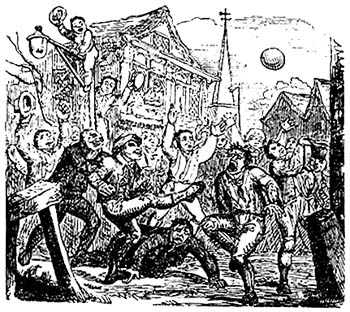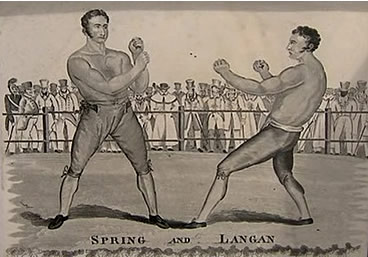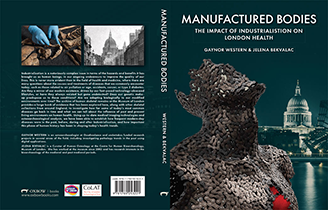Sport
Another source of multiple accidents and injuries is sport.
Although sport is heavily regulated today, this was not the case in the past and many sports up until the late Victorian period or even early 20th century involved heavy body contact, shoving, punching, biting, kicking and hair pulling!
There were many sporting activities going on in medieval London, though several mayors tried to ban them from time to time due to their rowdy and dangerous nature. Edward III issued a decree in AD1314 banning ‘stone, wood and iron throwing, handball, football, hockey, coursing, cockfighting and other such idle games’. Needless to say, he wasn’t very successful.
Another popular, though not necessarily safer, past-time was ice skating on the frozen rivers and marshes in London. Winter games included a chain of people dragging a seated person on their chair across the ice as well as pole-vaulting into each other, colliding mid air and falling onto the ice below. Ouch! In fact, the frozen Thames was the location for numerous entertainments and activities from at least AD1309 and through the Industrial period, including frost fairs.
One sport that was very much synonymous with the East End of London is boxing, or pugilism as it once was known. Boxing is an ancient sport gaining particular popularity as a public spectacle during the Industrial period, when bare-knuckle prize fighting began to be regulated and to be taken up by the gentry in the 18th century with the introduction of gloves. The fascinating history of boxing in the East End has been documented by Jeff Jones in his book ‘East End Born and Bled’, who gives us an idea of not only how boxing changed as a sport over time but also its role in the social history of the East End of London.
Jeff very kindly came into the Museum to give us an interview about his research, which you can listen to here:
Sports like mob football, for example, were extremely popular but hardly recognisable compared to what we know as football today. The only rule was that in getting the ball (at this time, an inflated animal bladder) from one end of the town to the other, neither manslaughter nor murder were permitted. Huge crowds of men would turn out for the event, often carrying their sheathed knives, leading mob-violence and carnage. The game is still played in Ashbourne, Derbyshire where it is known as Royal Shrovetide Football, and is still quite a bloody affair.
Unfortunately, not all violence in the city was as benign. Interpersonal violence is documented in historical records and is likely to have contributed significantly to some of the fractures and injuries we see in skeletal remains.
Next: Interpersonal violence










